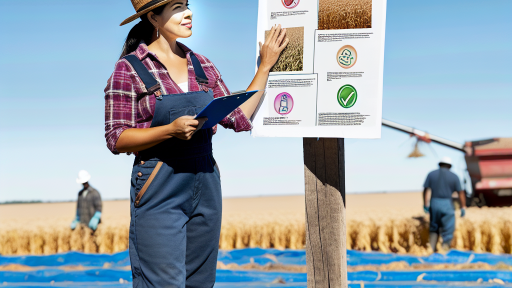Overview of Traditional Pesticides
Benefits of Traditional Pesticides
Traditional pesticides offer effective solutions for pest control.
They significantly reduce crop damage and increase yields.
Farmers often rely on these products for their reliability.
Moreover, traditional pesticides are widely available and heavily researched.
Limitations of Traditional Pesticides
Despite their benefits, traditional pesticides have notable drawbacks.
They can pose risks to human health and the environment.
Overuse may lead to pesticide resistance in pests.
Additionally, non-target species may suffer unintended consequences.
Consumer Concerns
Many consumers express concerns regarding pesticide residues on food.
There is growing demand for organic and sustainable alternatives.
Public awareness campaigns highlight these issues regularly.
Regulatory Landscape
Governments actively regulate the use of traditional pesticides.
Stricter regulations arise from environmental and health considerations.
Compliance with these regulations adds complexity for farmers.
Introduction to Alternative Pest Management Strategies
Farmers seek effective ways to control pests without traditional pesticides.
Transform Your Agribusiness
Unlock your farm's potential with expert advice tailored to your needs. Get actionable steps that drive real results.
Get StartedAlternative pest management strategies offer promising solutions.
These strategies reduce environmental impacts and improve safety.
Integrating various methods can enhance pest control efforts.
Understanding Integrated Pest Management
Integrated pest management (IPM) combines multiple techniques.
This approach considers ecological and economic factors.
IPM prioritizes long-term prevention over short-term control.
It uses monitoring to inform decision-making.
Farmers benefit from reduced pesticide use through IPM.
Biological Control Methods
Biological control leverages natural predators to manage pests.
This method restores ecological balance in agricultural systems.
For example, ladybugs control aphid populations effectively.
Farming practices can promote beneficial insects’ habitats.
Farmers can implement companion planting to enhance biological control.
Cultural Practices and Their Importance
Cultural practices can significantly impact pest management.
Crop rotation disrupts pest life cycles and enhances soil health.
Timing planting and harvesting can also reduce pest infestations.
Farmers should focus on proper sanitation to control pests.
This includes removing debris and managing waste effectively.
Developing Resistant Crop Varieties
Research in plant genetics leads to the development of resistant crops.
These crops withstand pests and diseases better than traditional varieties.
Farmers can select varieties based on local pest pressures.
Resistant crops reduce dependence on chemical pesticides.
Additionally, these crops can enhance overall yield stability.
Utilizing Natural Pesticides
Natural pesticides offer an alternative to synthetic chemicals.
Showcase Your Farming Business
Publish your professional farming services profile on our blog for a one-time fee of $200 and reach a dedicated audience of farmers and agribusiness owners.
Publish Your ProfileExamples include neem oil and insecticidal soap.
These options provide varying levels of pest protection.
Farmers should consider the application timing for effectiveness.
Moreover, natural pesticides often break down more quickly in the environment.
Biological Control: Utilizing Natural Predators and Parasites
Understanding Biological Control
Biological control focuses on using living organisms to manage pests.
This method contrasts sharply with traditional chemical pesticides.
By harnessing natural predators and parasites, farmers can reduce pest populations effectively.
Furthermore, it promotes ecological balance within agricultural systems.
Types of Biological Control Agents
Different types of biological control agents exist for pest management.
- Predators actively hunt and consume pest organisms.
- Parasitoids lay eggs inside or on pests, eventually killing them.
- Pathogens, such as bacteria and fungi, can infect and kill pests.
Each agent plays a significant role in integrated pest management strategies.
Benefits of Using Natural Predators
Natural predators offer several benefits over synthetic pesticides.
For instance, they are often more environmentally friendly.
Additionally, they pose fewer health risks to humans and wildlife.
Moreover, they typically promote sustainable agricultural practices.
Successful Applications in Agriculture
Numerous successful applications demonstrate the effectiveness of biological control.
Many farmers have reported significant reductions in pest populations.
For example, ladybugs are commonly used to control aphid infestations.
Another example includes using parasitic wasps to manage caterpillar pests.
Considerations and Challenges
Despite its advantages, challenges exist in implementing biological control.
Identifying appropriate natural agents can be complicated.
Additionally, the timing of introductions is crucial for success.
Finally, ensuring environmental compatibility remains essential.
Future Perspectives
The future of biological control appears promising as technology advances.
Research continues to explore new natural predators and parasitoids.
Furthermore, genetic research may enhance the effectiveness of these agents.
As a result, biological control could become a vital component of sustainable agriculture.
Delve into the Subject: The Role of Rural Development Policies in Enhancing Farm Sustainability
Cultural Practices: Crop Rotation and Diversification
Understanding Crop Rotation
Crop rotation refers to the practice of growing different crops in succession.
This method improves soil health and reduces pest buildup.
Furthermore, rotating crops can enhance nutrient management in the soil.
Farmers benefit by increasing crop yields over time.
Additionally, this practice minimizes the need for chemical interventions.
Benefits of Crop Diversification
Cultivating diverse crops can significantly enhance ecosystem stability.
Diversity helps attract various beneficial insects and pollinators.
Moreover, it reduces the prevalence of crop-specific pests and diseases.
A varied cropping system can lead to more resilient agricultural practices.
Farmers can also tap into different markets and maximize profits.
Implementing Effective Crop Rotation Strategies
Start by planning rotations based on specific crop families.
For example, legumes can enrich the soil with nitrogen.
Next, incorporate deep-rooted crops that improve soil structure.
Showcase Your Farming Business
Publish your professional farming services profile on our blog for a one-time fee of $200 and reach a dedicated audience of farmers and agribusiness owners.
Publish Your ProfileRotate crops seasonally to disrupt pest and disease life cycles.
Finally, adapt strategies based on local environmental conditions.
Creating a Strategy for Crop Diversification
Consider integrating cover crops into existing systems.
These crops prevent soil erosion and suppress weeds.
Experiment with different planting arrangements and timings.
Engage in community-supported agriculture for ideas and feedback.
Eventually, evaluate the economic viability of diversified crops.
Discover More: Adapting Farming Practices to Rural Development Policy Changes
Plant Resistance: Breeding and Genetically Modified Organisms (GMOs)
Introduction to Plant Resistance
Plant resistance is vital for sustainable agriculture.
This resistance helps crops endure various pests and diseases.
Farmers increasingly rely on plant breeding and GMOs to enhance resistance.
Traditional Breeding Techniques
Traditional breeding involves selecting plants with desirable traits.
Farmers have practiced this method for centuries.
Natural variation within plant species serves as a starting point.
Additionally, crossbreeding can yield offspring with enhanced traits.
This process requires time and careful observation.
Advantages of GMO Technology
GMO technology accelerates the development of resistant plant varieties.
This method allows for precise genetic alterations.
As a result, scientists can target specific traits efficiently.
Moreover, GMOs can reduce reliance on chemical pesticides.
This approach can lead to lower production costs for farmers.
Examples of Successful GMOs
Bt cotton is one example of a successful GMO.
This crop includes a gene from the bacterium Bacillus thuringiensis.
This gene produces a protein that is toxic to certain insects.
Consequently, Bt cotton significantly reduces the need for insecticide applications.
Another example is genetically modified soybeans that are resistant to herbicides.
This allows farmers to control weeds more effectively while minimizing damage to crops.
Challenges and Concerns
Despite their benefits, GMOs face public skepticism.
Some consumers express concerns about long-term health effects.
Additionally, there are worries about biodiversity loss.
Moreover, potential resistance development in pests poses a significant challenge.
Regulatory Framework and Safety Assessments
Governments worldwide regulate GMO technology to ensure safety.
This regulation includes thorough risk assessments before approval.
Scientific reviews evaluate potential environmental impacts and health risks.
This process aims to protect both consumers and ecosystems.
Future Directions in Plant Resistance
Research continues to explore new methods for enhancing plant resistance.
Gene editing technologies, like CRISPR, provide exciting possibilities.
These techniques could offer more precise ways to achieve desirable traits.
Furthermore, integrating traditional breeding with biotechnology shows promise.
Ultimately, a balanced approach could enhance food security sustainably.
Showcase Your Farming Business
Publish your professional farming services profile on our blog for a one-time fee of $200 and reach a dedicated audience of farmers and agribusiness owners.
Publish Your ProfileSee Related Content: Biodiversity Protection Laws for Farmers

Organic Pesticides: Efficacy and Environmental Impacts
Understanding Organic Pesticides
Organic pesticides derive from natural sources.
Farmers often use them to manage pests effectively.
These products come from plants, minerals, and microorganisms.
Consequently, many consumers prefer them over synthetic options.
Efficacy of Organic Pesticides
Research shows that organic pesticides can be effective.
For instance, neem oil has proven successful against various pests.
Additionally, diatomaceous earth targets insects with its abrasive texture.
However, effectiveness can vary based on application and environmental conditions.
Farmers should monitor their crops closely to assess outcomes.
Environmental Benefits
Using organic pesticides promotes ecological balance.
These products typically degrade faster in the environment.
They pose lesser risks to non-target organisms, such as beneficial insects.
Moreover, organic pesticides reduce chemical runoff into waterways.
Challenges of Using Organic Pesticides
Despite their benefits, organic pesticides present challenges.
Their shorter residual effects can lead to frequent applications.
Farmers may need to combine methods for effective pest management.
Additionally, some organic pesticides can still affect human health.
Careful handling and adherence to guidelines are essential.
Case Studies and Comparisons
Research often compares organic and conventional pesticides.
In one study, researchers analyzed the impact on biodiversity.
The findings indicated that organic options preserved more beneficial species.
Comparatively, synthetic pesticides showed greater declines in non-target insects.
These comparisons help inform best practices in agriculture.
Gain More Insights: Maintaining Records For Pesticide Compliance
Integrated Pest Management (IPM): A Holistic Approach
Understanding Integrated Pest Management
Integrated Pest Management, or IPM, offers a comprehensive strategy for pest control.
This approach combines various management techniques to minimize risks.
IPM emphasizes the use of natural pest control methods over chemical ones.
Farmers adopt practices that reduce pest populations while protecting beneficial organisms.
Core Principles of IPM
IPM relies on fundamental principles for effective pest management.
- Monitoring pest populations regularly is essential.
- Identifying pests accurately helps determine the best control methods.
- Setting action thresholds guides decision-making regarding interventions.
- Utilizing biological controls can reduce the need for chemicals.
- Cultural practices encourage robust crop health and minimize pest impacts.
Benefits of Implementing IPM
Implementing IPM provides numerous advantages for growers and the environment.
This strategy encourages sustainable farming practices that enhance soil health.
Moreover, it lowers pesticide residues in food, promoting consumer safety.
IPM also supports biodiversity by protecting non-target species.
Challenges in Adopting IPM
While IPM offers many benefits, growers may encounter challenges in its implementation.
Access to education and resources is critical for successful adoption.
Furthermore, some farmers may resist changing traditional practices.
Economic factors can influence the feasibility of IPM strategies.
Future Directions for IPM
Future advancements in technology will enhance IPM practices.
Data analytics can improve pest monitoring and prediction models.
Showcase Your Farming Business
Publish your professional farming services profile on our blog for a one-time fee of $200 and reach a dedicated audience of farmers and agribusiness owners.
Publish Your ProfileMoreover, integrating precision agriculture with IPM will optimize pest management efforts.
Continued research will expand the tools available for effective pest control.
Regulatory Framework: Evaluating Safety and Efficacy of Alternatives
Understanding Current Regulations
The regulatory landscape for pesticides is complex and evolving.
Governments worldwide enforce stringent rules to ensure public safety.
These regulations guide the approval and use of alternative pesticides.
They aim to minimize health risks for humans and the environment.
Key Safety Evaluations
Evaluating alternatives involves rigorous safety assessments.
Regulatory agencies perform toxicity tests on various organisms.
These tests assess the potential harm to beneficial insects and animals.
Also, they consider risks to human health through exposure pathways.
Effectiveness of Alternatives
Efficacy testing determines how well alternatives control pests.
This stage involves field trials to compare performance against traditional pesticides.
Effective alternatives must provide comparable pest control results.
Investigators also analyze how quickly alternatives perform against infestations.
Environmental Impact Assessments
Environmental assessments play a critical role in the regulatory process.
Regulators examine how alternatives affect ecosystems.
These evaluations consider fate and transport in soil and water systems.
They also analyze potential non-target species impacts.
Global Perspectives on Regulation
Different countries approach pesticide regulation with varying philosophies.
Some prioritize a precautionary principle while others focus on industry innovation.
This leads to diverse regulatory timelines and safety standards.
Harmonization efforts aim to create a unified global framework.
The Path Forward for Alternatives
Ongoing research enhances understanding of alternative solutions.
Stakeholders advocate for transparency in the evaluation process.
This fosters trust between the public, regulators, and manufacturers.
Collaboration among researchers can drive innovation in sustainable practices.
Additional Resources
Environmental, Energetic, and Economic Comparisons of Organic …




